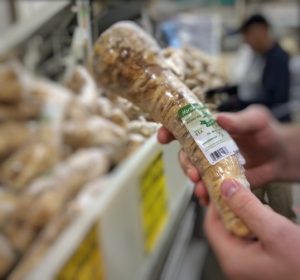Did you know Illinois is know for growing horseradish? Ok, maybe it’s not as famous for that as it is for Chicago’s Miracle Mile, but the majority of the horseradish eaten in the US is grown in Illinois/Missouri area.
(A transcript for this episode about horseradish is available.)
Happenstance Piqued My Interest
Years ago a farmer drove me by a neighbor’s horseradish field and it raised a lot more questions than it answered! Question have been growing ever since and I’m surprised how many people, when they heard I was headed to a horseradish farm, launched into questions too.
I found the perfect interview with Matt McMillan! He seemed to enjoy answering the questions as much as I enjoyed getting answers.
Matt lives just a short drive east of St. Louis in Collinsville, IL. the “world’s horseradish capital.” And we sat down to talk about what makes the condiment and plant so unique. And seriously, you can hear the enthusiasm throughout the visit in the podcast episode and the accompanying video.
Enjoying Horseradish
Horseradish isn’t something everyone thinks about when they start listing favorite foods, but the distinctive shredded root is a great compliment that enables some of us to better enjoy favorite foods like prime rib, oysters and it puts a bite in bloody marys too!

It’s a different kind of spice though as it hits you in your sinuses, rather your tastebuds like a ghost pepper or something. That kick is short-lived with horseradish and hot mustards too (the plants are both part of the brassica family). Matt says that’s based on the oil released. So you don’t want to let horseradish dry up.
For a lot of us, horseradish is a sauce, more than a few people I talked to couldn’t picture a horseradish plant.
But it’s a big root that is grated to provide the condiment we use. If you are like me and haven’t bought horseradish in the produce section, this video with Andrew Zimmern shows how to prepare horseradish.
What’s growing horseradish look like?
Getting Matt to take me out to a farm really helped me picture it. The plant grows low to the ground, putting most of the energy into making that root big. Horseradish is planted in the spring (April-May) by planting secondary roots from a previous crop. It is harvested starting in September but can go as late as May as the root comes out of dormancy and will be growing again come spring.
This video not only shows Matt digging up a horseradish, but we talk about how it’s planted & harvested and you’ll see video from that Matt was nice enough to share.
Because horseradish is a niche crop that requires so specialized equipment, there are only a couple dozen farmers who grow it at scale. Almost all of them are headquartered in the Collinsville area. It can be grown in gardens at home though and just this week I was listening to a book where someone talked about growing it.
Barry McMillan (Matt’s dad) did an interview a little while back and explained that horseradish takes a lot of labor but also offers farmers a good return if they can do it at scale.
Horseradish Festival
The small town of Collinsville hosts a horseradish festival the first weekend in June each year. You’ll hear Matt & I talk about it a bit in the podcast episode. You can find more information on the festival’s Facebook page or website.




One comment on “Getting to the Root of Enjoying & Growing Horseradish!”